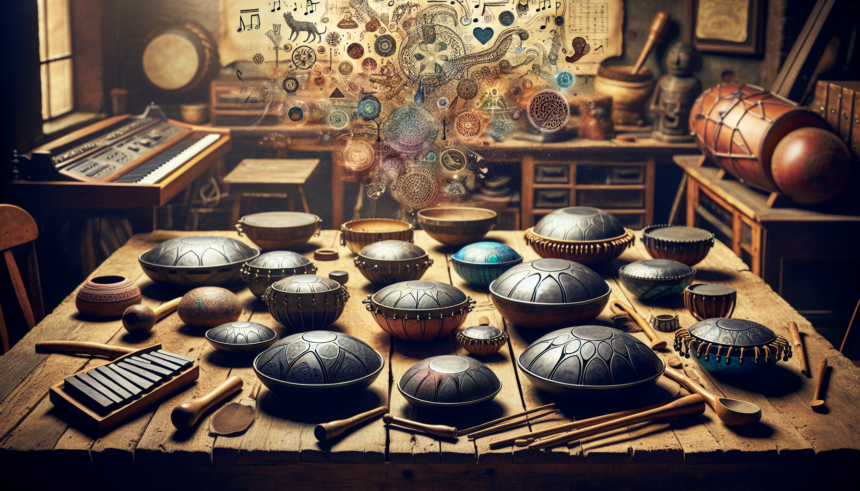<!DOCTYPE html>
<html lang="en">
<head>
<meta charset="UTF-8">
<meta name="viewport" content="width=device-width, initial-scale=1.0">
<title>Handpan Origins</title>
</head>
<body>
<article>
<p>The handpan, a unique and intriguingly resonant instrument, has captured the hearts of musicians and music enthusiasts worldwide with its ethereal sound and distinctive design. This musical device, often compared to the steel drum, offers a meditative experience to both player and listener. To truly understand the handpan, one must explore its origins, the pioneers who crafted its first manifestations, and the inspirations and challenges they encountered throughout the process.</p>
<h2>Early Inspirations and the Birth of a New Sound</h2>
<p>The story of the handpan begins in the late 20th century with the innovations and experiments related to steel pans. The steel pan, originating from Trinidad and Tobago, laid the groundwork for future steel-based instruments due to its percussive yet melodic capabilities. Musicians and instrument makers recognized the potential to develop further in the realm of steel percussion, leading to explorations that would eventually give birth to the handpan.</p>
<p>The desire to create a compact and versatile steel instrument that could be played with hands instead of mallets was a driving factor in its development. The quest for an instrument that could produce lush harmonies without cumbersome machinery was appealing to many musicians seeking a more personal and tactile musical experience.</p>
<h2>Felix Rohner and Sabina Schärer: The Inventive Duo</h2>
<p>The creation of the handpan is primarily credited to Felix Rohner and Sabina Schärer, two Swiss musicians and innovators who founded PANArt, a company that would become synonymous with handpan production. In the late 1990s, inspired by the instrumental landscape across various cultures, they sought to create an instrument capable of transcending typical sonic boundaries.</p>
<p>By 2000, their efforts culminated in the invention of the Hang, a name derived from the Swiss German word for “hand.” The Hang was distinct not only in its sound but also in its structure. It comprised two saucer-like shells made from nitrided steel glued together, forming a hollow cavity. The upper shell featured a central dome ('Ding') and nine-tone fields arranged in a circle, each carefully hand-tuned. The bottom half, called the 'Gu,' had a resonant opening akin to an udu drum, contributing to the Hang’s rich, enveloping sound.</p>
<h2>The Spread and Influence of the Handpan</h2>
<p>The Hang received immense acclaim and quickly garnered a following due to its unique sound and organic form. As musicians across the globe encountered the Hang, many sought to understand and ideally replicate its formidable attributes. However, PANArt was firm in its stance on limited production, making Hangs rare and coveted musical treasures.</p>
<p>This exclusivity and the increasing demand led other artisans to innovate further. Handpans began to emerge from various creators globally, each adding their own cultural influences and technological advancements. Artisans began experimenting with scales, scene acoustics, and shapes, enriching the world of handpans beyond the original conceptualization by Rohner and Schärer.</p>
<h2>Challenges and Artistic Liberties</h2>
<p>One of the primary challenges in crafting a handpan lies in finding the perfect balance between aesthetics, material choice, and sound quality. Crafting a handpan involves meticulous processes that require both inventive techniques and traditional craftsmanship. Different steel treatments, tuning methods, and designs place each handpan maker on a journey of continuous learning and adaptation.</p>
<p>Structural defects or resonant inconsistencies can significantly affect the instrument's performance, prompting handpan makers to dedicate years toward mastering their craft. Despite these challenges, handpan artists find beauty in the unpredictability and individuality of each instrument, often viewing their creations as collaborations with nature.</p>
<h2>The Philosophical and Musical Inspirations</h2>
<p>Beyond technical innovation, the handpan is deeply intertwined with philosophical and spiritual aspirations. Musicians see the handpan not just as an instrument, but as a conduit for introspection and connectivity with the environment. The experience of playing encourages mindfulness, creativity, and emotional expression.</p>
<p>From its origin, the handpan has been linked with therapeutic and meditative practices. Its vibrations and harmonics often resonate with listeners far beyond the surface level, enabling a peaceful escape from everyday life. This aspect of the handpan continues to inspire both established and aspiring musicians in their personal and collective musical journeys.</p>
<h2>The Evolution of Techniques and Community</h2>
<p>
Since its inception, the handpan community has grown exponentially, fostering an inclusive environment for sharing and exploration. Workshops, festivals, and social media platforms serve as collaborative hubs where enthusiasts and creators alike exchange ideas and techniques. The evolution of handpan music incorporates diverse genres, ranging from ambient, classical, and experimental soundscapes to contemporary global expressions.
</p>
<p>
Pioneering artists often share resources such as tuning methods, composition styles, and performance tips, establishing a rich network akin to a musical laboratory. This ecosystem not only sustains handpan crafting as an art form but also ensures its vitality and adaptability in a rapidly changing musical landscape.
</p>
<h2>The Continuing Legacy and Vision</h2>
<p>
As handpans continue their journey, their builders and players remain focused on innovation and authenticity. The legacy of Pane, Rohner, and Schärer serves as a testament to the impact of uniting artistic intuition with visionary craftsmanship. Inspired by a profound sense of purpose, today’s handpan creators constantly seek new materials, cultural bridges, and acoustic marvels.
</p>
<p>
Increasingly influenced by renewable practices and sustainable materials, modern artisans align their processes with ecological consciousness. This forward-thinking approach embraces not only the cultural significance of the handpan but also its role in fostering a harmonious relationship with the earth.
</p>
<h2>Conclusion</h2>
<p>The journey of the handpan from its inception to its present-day incarnation illustrates a powerful blend of innovation, tradition, and inspiration. The original creators, Felix Rohner and Sabina Schärer, forged not only an instrument but also a legacy that has sparked creativity across the globe. As the community of musicians and artisans continues to grow, the handpan transcends its origins, becoming a symbol of cultural connectivity and a tool for personal expression. It encapsulates the sounds of the world, inviting all who play and listen to embark on a journey of their own.</p>
<h2>FAQs</h2>
<h3>1. What is a handpan?</h3>
<p>A handpan is a percussion instrument made from steel that resembles two hemispheres. It is played by striking its tuned areas with the hands, producing a range of melodic tones and harmonics.</p>
<h3>2. Who invented the first handpan?</h3>
<p>Felix Rohner and Sabina Schärer, founders of PANArt, are credited with inventing the first handpan, known as the Hang, in the early 2000s in Switzerland.</p>
<h3>3. What is the difference between a Hang and a handpan?</h3>
<p>All Hangs are handpans, but not all handpans are Hangs. The Hang is the original handpan created by PANArt. The term 'handpan' has since been adopted to describe similar instruments developed by other manufacturers.</p>
<h3>4. How is a handpan played?</h3>
<p>A handpan is played using the hands to strike its tone fields. Players use various techniques to elicit a wide array of sounds, from gentle tapping to more expressive percussive hits.</p>
<h3>5. Are handpans used in therapy?</h3>
<p>Yes, handpans are frequently used in therapeutic settings due to their soothing sound. Many practitioners incorporate handpans into meditation sessions, sound healing, and wellness practices.</p>
</article>
</body>
</html>Handpan Origins: Exploring the First Makers and Their Inspirations

Leave a comment




